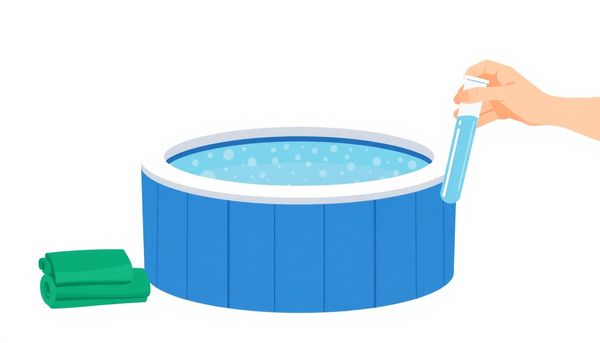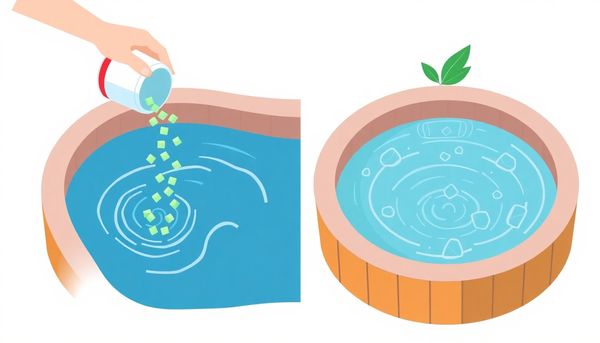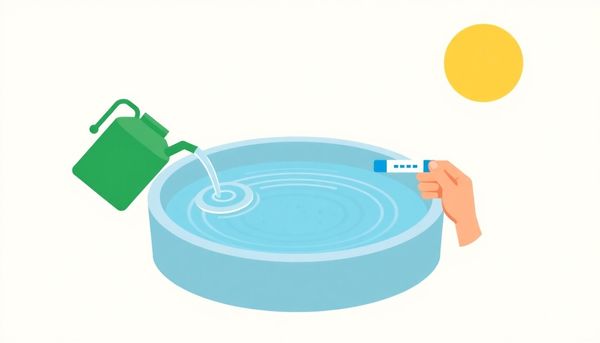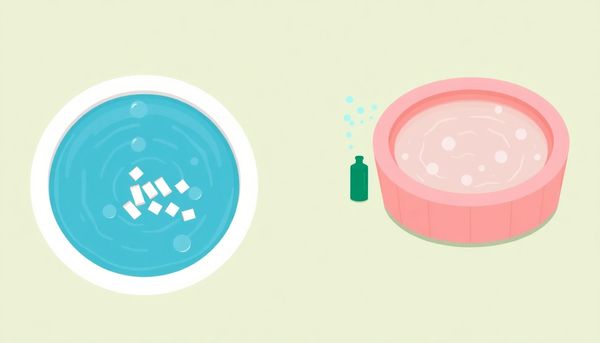Lower Chlorine Levels in Your Hot Tub: Fast and Effective Methods
June 05th, 2024
June 05th, 2024
After a long day, nothing beats the soothing embrace of a bubbling hot tub. Yet, for many, that blissful soak can be interrupted by the scent of overpowering chemicals. High chlorine levels, while necessary for keeping your spa clean, can quickly turn relaxation into irritation. It stings the eyes, dries the skin, and leaves you questioning your next dip.
Recently, I faced this issue firsthand. Eager for a peaceful evening soak, I uncovered my hot tub only to be met with a sharp, unpleasant odor. My initial excitement vanished as I realized the chlorine levels were much too high. Instead of enjoying my evening, I embarked on a mission to quickly restore balance.
Understanding the delicate chemistry of hot tub maintenance is essential. Chlorine, while a powerful ally against bacteria, can become an unwelcome guest if not managed correctly. Misjudging the amount added or forgetting to test the water regularly can easily lead to excess.
Solutions, however, are at hand. Whether it's diluting the concentration with fresh water or using a chlorine neutralizer, there are effective methods to swiftly bring things back to normal. The key lies in recognizing the problem early and knowing which steps to take.
In the following sections, we will explore practical strategies to lower chlorine levels fast, ensuring that your hot tub remains an oasis of calm rather than a chemical conundrum.

Testing your hot tub water for chlorine levels might sound tedious, but it’s a crucial step in maintaining a clean and comfortable soaking experience. Imagine coming home after a long day, ready to unwind, only to be met with stinging eyes and irritated skin. This scenario can often be traced back to improperly balanced chlorine levels rather than an excess of chlorine itself. That’s why understanding the nuances is essential.
The first thing you’ll need is a reliable test kit or test strips designed for hot tubs. These handy tools will help you assess both free and combined chlorine levels. Free chlorine refers to the active agents that are ready to sanitize your water, while combined chlorine indicates the presence of chloramines, the culprits behind that notorious chlorine smell. A balanced hot tub should have free chlorine levels between 1 and 3 parts per million (PPM).
When you’re testing, it’s vital to focus on both free and total chlorine. If your total chlorine level is high but your free chlorine is low, you’re dealing with an abundance of chloramines. This situation calls for a non-chlorine shock treatment to break down these compounds, effectively refreshing your sanitizer’s efficiency.
Regular testing ensures you catch imbalances early, preventing potential damage to both your skin and the hot tub’s surfaces. Keeping a close eye on your chlorine levels, alongside other chemical balances, is the secret to a consistently enjoyable hot tub experience.
Understanding chlorine levels in your hot tub can feel a bit like unraveling a mystery. You might be tempted to blame that strong aroma or slight irritation on excess chlorine, but often the real culprit is lingering chloramines. Before taking any action, grab a test strip or digital tester to gauge your water’s true chlorine status. These handy tools can quickly measure both free and total chlorine, offering a snapshot of what’s happening beneath the bubbles.
You’ll want your free chlorine levels to hover between 1 and 3 parts per million (PPM). This measurement indicates how much chlorine is actively ready to tackle bacteria and other unwanted guests. If the free chlorine is low but the total chlorine is high, those pesky chloramines are likely to blame. This scenario calls for a non-chlorine shock, a quick fix to rejuvenate your sanitizer and clear out those odorous compounds.
It’s surprising how a simple test can clarify whether you’re dealing with too much or too little of this essential chemical. Once you’ve confirmed a real chlorine surplus, you can explore solutions like ceasing chlorine input or letting nature lend a hand. With the right balance, your hot tub can return to its role as a soothing escape, free from the irritation and confusion of mismanaged chlorine levels.
Navigating the delicate balance of chlorine in a hot tub can seem like a tightrope walk, but it doesn’t have to be. When chlorine levels tip too high, it can lead to discomfort and potential damage. However, lowering these levels can be as simple as letting nature lend a hand. Pause any chlorine inputs—like floating dispensers or automatic systems—and let the existing chlorine fade naturally. Sunlight is a powerful ally in this process. By removing the hot tub cover and letting the sun do its work, you can expedite chlorination dissipation. Remember to activate the jets; the increased water movement aids evaporation, speeding up the reduction of chlorine.
It's important to keep an eye on water levels during this time. As evaporation occurs, your water level may drop. Ensure it stays above the skimmer port to avoid pump issues. Once evaporation has lowered the chlorine level sufficiently, replenish with fresh, filtered water. This dilution helps stabilize not just chlorine, but also balances out other crucial elements like pH.
For those needing a quicker fix, consider a chlorine neutralizer. While effective, it requires care to avoid overuse, which could strip the sanitizer protection entirely. A balanced approach, mixing patience with periodic testing, keeps your hot tub a safe, relaxing oasis. Ultimately, finding the right rhythm with your hot tub care routine ensures you can savor every soak without the sting.
Maintaining a hot tub is somewhat like caring for a cherished pet; it requires regular attention and a bit of foresight. One significant aspect of this care is regular maintenance, which plays a crucial role in controlling chlorine levels. By setting a consistent routine, you can prevent the overaccumulation of chlorine before it becomes a problem.
Start by scheduling weekly water tests. These tests will give you a clear picture of your chlorine levels, ensuring they remain within the ideal range of 1 to 3 PPM. Use a reliable test kit to check not only chlorine but also pH and alkalinity levels. This helps maintain a balanced environment, minimizing skin irritation and protecting your hot tub surfaces from corrosion.
Don't overlook the importance of cleaning your filters. Clogged filters can impede water flow, affecting how well your sanitizer circulates. Rinse the filters every week and give them a thorough cleaning monthly. This simple step can significantly enhance your hot tub's efficiency and water quality.
Regularly drain and refill the hot tub, ideally every three months. Fresh water rebalances the chemical levels naturally, reducing the need for additional chemicals. In my own experience, adhering to this routine has saved me numerous headaches and ensured my hot tub remains a welcoming retreat, rather than a source of frustration. Implementing these practices not only keeps your chlorine levels under control but also prolongs the life and enjoyment of your hot tub.

Chlorine overload in a hot tub can seem like a pesky problem, but often the simplest solution is to cease adding more of it. In the excitement of keeping water pristine, it’s easy to fall into the trap of over-chlorination, thinking more is merrier. However, if the chlorine levels are already elevated, continuing to add more is akin to pouring water into an already full cup—it achieves nothing but waste and potential harm.
Identify the source of chlorine and deal with it directly. If you rely on an automatic chlorinator or use a chlorine floater, it's time to hit pause. Turn off that chlorinator or take out the floater. This halts the constant influx of chlorine, allowing the existing levels a chance to naturally dissipate.
From there, mother nature can lend a hand. Allowing the hot tub to breathe, so to speak, helps in reducing the excess naturally. Simply remove the cover and switch on the jets. This will promote evaporation, especially under the sun's warmth. It's like giving your hot tub a breather and allowing the excessive chlorine to escape peacefully into the air.
As the water level dips due to evaporation, it’s essential to ensure it doesn't drop below the skimmer port. Keep an eye, and once a few inches are gone, replenish with fresh, filtered water. This not only dilutes the chlorine but also maintains balance. A little patience combined with these steps can effectively bring down those chlorine levels without unnecessary intervention.
High chlorine levels in a hot tub can be a nuisance, but the solution begins by identifying and eliminating the sources of excess chlorine. Often, the culprit is an overzealous chlorinator or an unattended chlorine floater bobbing around. Pause the introduction of chlorine by removing these devices. This straightforward step prevents further accumulation and gives you a chance to reassess the chemical balance of your tub.
Turning attention to the sun can be surprisingly effective. Direct sunlight acts as a natural chlorine dissipator. Remove the hot tub cover and let the rays work their magic. This not only hastens chlorine evaporation but also enhances the experience of maintaining your tub—after all, who doesn’t enjoy a sunny day? While the sun plays its role, keep the jets running. This helps in stirring the waters, promoting quicker evaporation and ensuring chlorine levels drop at a steady pace.
Monitor the water level as it may dip during this process. Avoid the risk of damaging your system by ensuring it never falls below the skimmer port. Once the evaporation process has made its mark, replenish the tub with fresh water, which naturally dilutes the remaining chlorine. Testing the water post-refill is crucial; a balanced hot tub is about more than just chlorine, as pH levels also demand attention. By addressing and eliminating chlorine sources, you lay the foundation for a perfectly balanced soak.
Chlorine, while essential for maintaining a clean hot tub, can become a nuisance if not properly managed. One effective approach to balance those levels is to encourage the natural evaporation of chlorine. This method is as straightforward as it is efficient, requiring just a bit of patience and a touch of sunshine.
During an afternoon gathering, I once noticed the distinct smell of chlorine overpowering our backyard. The solution was unexpectedly simple. By removing the hot tub cover and turning on the jets, I allowed the chlorine in the water to interact with the open air. The turbulence from the jets facilitates this process by increasing the surface area for evaporation, effectively giving chlorine the boot. The added bonus? Sunlight acts as a natural enhancer, breaking down chlorine through UV exposure. Just remember, it's best to keep the hot tub vacant during this time to allow the water chemistry to adjust without interference.
A small word of caution: keep an eye on the water level. Evaporation will decrease it, and if it drops too low, it might affect the water's circulation system. After some time, you can top up with fresh, filtered water, then recheck the levels to ensure everything remains balanced. This simple practice not only keeps your chlorine levels in check but also saves you the hassle of chemical additives.
Observing your hot tub transform from a relaxing oasis to a chemical overload is never ideal. When faced with high chlorine levels, chemical agents can come to the rescue with precision and speed. Sodium thiosulfate, a popular chlorine neutralizer, swiftly lowers chlorine concentrations, ensuring your tub returns to its soothing state without delay. It acts much like a reset button for your water chemistry, effectively neutralizing excess chlorine. However, wield this powerful tool with caution—too much can strip your tub of essential sanitizing power.
In my own experience, a sunny afternoon soak became a lesson in chemistry. The chlorine levels in my hot tub had spiked unexpectedly, and traditional methods were just too slow. Turning to sodium thiosulfate, I learned firsthand the importance of meticulous measurement. A small misstep can result in under- or over-dosing, leaving your tub unprotected or still too harsh on the skin. For precision, always adhere to the instructions on the packaging, and use only as much as necessary.
Moreover, chemical agents are best seen as a quick fix rather than a regular solution. By incorporating them into your maintenance routine sparingly, you ensure your hot tub remains a safe and enjoyable retreat. Always reassess your tub's chemical balance after using these agents to maintain the delicate harmony of your water chemistry.
Chlorine levels in a hot tub can sometimes spike unexpectedly, causing discomfort and potential damage. One effective and straightforward method to mitigate this is by promoting chlorine evaporation. Consider my own experience when, after an extended family gathering, my hot tub's chlorine levels soared. To combat this, I embarked on a natural approach, using the elements to my advantage.
Begin by ensuring your hot tub is exposed to open air. Remove the cover and allow nature to take its course. Sunlight plays a pivotal role here; ultraviolet rays have the power to break down chlorine compounds, thereby reducing the concentration. It's worth noting that running the jets can further expedite this process by agitating the water surface, making it easier for chlorine to escape into the atmosphere. During my chlorine correction mission, I noticed a significant drop in levels after just a few hours of exposure to direct sunlight and vigorous jet action.
However, while this method is effective, keep a close eye on water levels. Evaporation doesn't discriminate; it will reduce water volume too. Ensure the water doesn't dip below the skimmer line, and top up as necessary with fresh, filtered water. This not only maintains proper levels but also helps dilute the concentration of chlorine further. After your adjustments, always follow up with a test to ensure all chemical levels are balanced. This two-pronged approach of using sunlight and jets is a gentle yet potent way to restore comfort and safety to your hot tub.
Halting the influx of chlorine into your hot tub is a straightforward yet crucial step when you're wrestling with excessive chlorine levels. It's akin to cutting off the supply line in a strategic game—stop feeding the problem, and it slowly resolves itself. Begin by temporarily discontinuing any automatic chlorinators or removing chlorine floaters that are resting in your tub. These devices, though helpful under normal circumstances, can exacerbate the issue when your chlorine levels are already skyrocketing.
A friend once found themselves in a chlorine conundrum after a particularly enthusiastic pool party, and simply turning off the chlorinator worked wonders. Within a couple of days, the chlorine levels began to stabilize, all without adding anything new to the water. Nature often has a way of correcting itself, and in this case, it comes in the form of evaporation.
By allowing the hot tub to breathe—removing the cover and activating the jets—you encourage the natural dissipation of chlorine. Sunlight acts as a catalyst in this chemical reduction process, so exposing your tub to direct sunlight can hasten the decrease in chlorine levels. Just ensure you’re not using the tub during this time to avoid skin irritation.
Remember, this is just the first move in your strategic game plan. Keeping tabs on the water level and topping it up as needed ensures that the system continues to function smoothly without unnecessary strain. It's a simple yet effective strategy to reclaim the balance in your hot tub.
Chlorine evaporation is a simple yet effective way to manage high levels in your hot tub without resorting to chemicals. Begin by halting any chlorine addition, whether from an automatic dispenser or floater. Once the source is controlled, leverage your hot tub’s jets. Turning them on creates movement and speeds up the natural evaporation process.
Moreover, removing the hot tub cover lets sunlight and air work their magic. Sunlight not only aids evaporation but also naturally breaks down chlorine. However, ensure no one is using the hot tub while the chlorine dissipates, as the process can take several hours to a couple of days, depending on the initial levels.
Throughout this period, remember to keep an eye on the water level. The evaporation can cause it to drop, which might affect your tub's circulation. Avoid letting it fall below the skimmer port to ensure everything runs smoothly. Once evaporation has reduced the chlorine concentration, restore the water level by adding fresh, filtered water. This not only helps dilute remaining chlorine but also balances the overall water chemistry.
Finally, after the adjustments, grab your trusty test kit. Reassessing the chlorine levels ensures they are back within the ideal range. Regular checks and patience with evaporation help maintain a balanced and enjoyable hot tub experience without unnecessary chemical intervention.
Chlorine neutralizer can be your best friend when you're looking to quickly reduce chlorine levels in your hot tub. Think of it as a fast-acting remedy for those moments when patience runs thin. I remember a time when I hosted a spontaneous backyard gathering, only to find out the chlorine was off the charts just an hour before guests were due to arrive. A chlorine neutralizer saved the day, bringing levels back to comfort without the wait.
Utilizing a chlorine neutralizer is straightforward but requires careful handling. These neutralizers, typically made of sodium thiosulfate, work by deactivating free chlorine molecules. However, it’s crucial to measure accurately; adding too much can strip the water of its sanitizing power entirely, leaving it vulnerable to bacteria and algae. Always start with a small amount, retesting your chlorine levels after each addition until you reach the desired range of 1 to 3 parts per million (PPM).
As a rule of thumb, treat neutralizers as a quick fix rather than a regular solution. Over-reliance could lead to more frequent imbalances, needing constant monitoring and adjustment. For routine maintenance, sticking to a consistent care schedule and understanding your water's chemistry helps prevent the need for emergency measures. A little preparation can go a long way, ensuring your hot tub remains a safe and inviting retreat whenever you need a soak.

Swapping out some of your hot tub's water is a practical way to swiftly manage excessive chlorine levels. A close friend once shared a story about her hot tub party mishap, where she accidentally added too much chlorine just hours before guests arrived. Her quick fix? She partially drained the tub, then refilled it with fresh water. In no time, the chlorine smell was gone, and the water was inviting again.
To start, ensure you've stopped any automatic chlorine additions by disabling any chlorine dispensers. This halts any further increase in chlorine levels. Next, remove a portion of your hot tub's water—around 20% should suffice. You can use a submersible pump or even a simple garden hose siphon to help with this. Once a portion is removed, replace it with fresh, filtered water, which will help dilute the high chlorine concentration.
Allow the fresh water to circulate by running the jets for a few minutes. This not only ensures a thorough mix but also helps balance other chemical levels that may have shifted. After circulation, test your water again to check the chlorine levels and make necessary adjustments to pH and alkalinity. This process might need repeating if levels are still too high, but it’s a straightforward method that doesn’t rely on chemical neutralizers. Regularly checking and maintaining balanced water chemistry will help you avoid such situations in the future.
Testing and adjusting chlorine levels in a hot tub can seem daunting, yet it’s a crucial step in ensuring a safe and enjoyable soak. Imagine sharing a relaxing evening with friends in your hot tub, only to be interrupted by stinging eyes and skin irritation. The culprit? Imbalanced chlorine levels. Begin by arming yourself with a reliable test kit, which will accurately measure both free and combined chlorine in your water. Free chlorine is your active sanitizer, while combined chlorine, or chloramines, are used-up particles that often cause that unpleasant smell.
Once you’ve tested your levels, interpret the results carefully. Aim for a free chlorine level between 1 and 3 parts per million (PPM), while keeping a keen eye on any disparities between free and total chlorine levels. A high total chlorine but low free chlorine can indicate a buildup of chloramines, suggesting that a non-chlorine shock treatment might be necessary to break down these compounds. This simple step can revitalize your water, making it clean and fresh without adding more chlorine.
After addressing chloramines, it’s essential to recheck your chlorine levels before adjusting further. Remember, overzealous use of chlorine neutralizers can strip your water of its sanitizing power. Balance is key, and patience is your ally. Regularly testing and tweaking chlorine levels keeps your hot tub inviting and safe, ensuring your next soak is free from irritation and full of relaxation.
The moment you realize your hot tub has turned into a mini chlorine factory, it's time to take action. First, put a halt to any new chlorine additions. That means if you’ve been relying on a chlorine floater or an automatic chlorinator, it’s time to give them a break. Think of it as hitting pause on a process that's gotten a bit too enthusiastic for its own good.
In my own backyard spa adventures, I've learned that tackling high chlorine levels challenges patience. A friend once overloaded their tub with chlorine tablets, thinking it would guarantee cleanliness, and ended up with water that smelled more like a public pool than a relaxing retreat. The first thing they did? They fished out that pesky floater immediately.
By stopping any additional chlorine input, you allow the existing chlorine the opportunity to naturally dissipate. This reduction doesn’t happen instantly, but within a day or two, you’ll notice levels starting to drop. It's a bit like letting steam escape from a pressure cooker. During this time, ensure your hot tub's jets are bubbling away, and if the weather is cooperative, remove that cover to let the sun work its magic. Just remember to keep the water level in check.
By giving your hot tub a breather from constant chlorine bombardment, you not only protect its surfaces but also ensure your next soak is a skin-friendly escape.
Chlorine, that necessary sanitizer, can sometimes overstay its welcome in your hot tub. When faced with elevated levels, one might find a simple yet effective ally in the natural process of evaporation. Encouraging chlorine to evaporate can be achieved with a few straightforward steps designed to nudge your hot tub back to comfort levels.
Start by opening up your hot tub to the elements. Removing the cover allows sunlight and fresh air to do their work. Sunlight, in particular, serves as a catalyst, breaking down chlorine through its ultraviolet rays. On a sunny day, the combination of solar exposure and circulating water can significantly speed up the dissipation process.
Circulation is another pivotal factor. Activating the jets increases water movement, promoting the release of chlorine gas from the water's surface. This method is akin to using a fan to dry a wet floor—constant motion facilitates quicker results.
A word of caution: while encouraging evaporation, monitor your water levels closely. As the chlorine evaporates, so might some of your water, necessitating a top-off with fresh, filtered water. This helps not only in maintaining the ideal water level but also in further diluting the chlorine concentration.
With these simple tweaks, you can efficiently reduce chlorine levels without resorting to chemicals. It's a natural, effective way to ensure your hot tub remains a haven of relaxation.

A friend once shared an amusing tale about his hot tub mishap: in a panic to lower chlorine levels, he dumped in heaps of chlorine neutralizer, only to spend the next week frantically trying to bring them back up. Chlorine neutralizer, often made from sodium thiosulfate, acts swiftly to counteract excessive chlorine, but one must wield it with care. The temptation to pour it all in at once can be strong, especially if the smell of chlorine is particularly pungent. However, patience is key. A little goes a long way. Overdoing it can leave your hot tub inadequately sanitized, which is not only ineffective but potentially unsafe.
Instead, a measured approach is wise. Begin by testing your water accurately to see just how high the chlorine levels are. Remember, the goal is to gently nudge those levels back into balance, not to obliterate them. Once you have the numbers, add the neutralizer in small increments, allowing time for it to circulate fully before retesting. It’s a bit like seasoning a soup—add, stir, taste, and adjust.
In the world of hot tub maintenance, restraint is often your best ally. By employing chlorine neutralizer thoughtfully, you’ll maintain that perfect splash zone between safety and comfort. Plus, you’ll save yourself the headache of recalibrating the entire chemical balance of your beloved tub.
When it comes to maintaining a hot tub, understanding chlorine balance is crucial. A telltale sign of imbalance might not always be what it seems. If a harsh chlorine smell greets you or your eyes sting post-soak, the issue could be chloramines rather than an overdose of chlorine. Chloramines form when chlorine mingles with impurities, causing that misleading smell. In such cases, more chlorine—not less—is often needed to tackle the chloramines and keep your tub pristine.
To accurately assess the situation, testing is indispensable. Your toolkit should include testing strips or a digital tester to measure free chlorine levels. Free chlorine is the active component, ready to neutralize bacteria and contaminants. Meanwhile, combined chlorine represents the used-up portion, contributing to unwanted smells and irritation. If you find total chlorine levels are disproportionately high compared to free chlorine, it's a sign that combined chlorine is dominating your tub.
Testing your water will reveal whether a chlorine reduction is necessary. Ideally, hot tub chlorine should rest between 1 and 3 parts per million (PPM). With mineral systems, you can maintain lower levels around 0.5 PPM. Should tests confirm an excess of free chlorine, manual interventions like removing chlorine dispensers, aeration, or exposure to sunlight can help reduce levels naturally. Always ensure your pH is balanced as well, because a well-maintained pH supports effective chlorine performance and minimizes skin discomfort.
Chlorine levels in a hot tub can sometimes get out of hand, creating an unpleasant experience for users. The good news? Encouraging chlorine evaporation can swiftly address the issue. By allowing chlorine to naturally dissipate, you're not only restoring balance but also safeguarding your tub’s components and your skin from potential irritation.
Begin by switching on the jets and removing any cover that might be trapping the chlorine. This simple action allows more of the chemical to escape into the air. Direct sunlight can further accelerate this process, as UV rays help break down chlorine molecules. If your hot tub is situated outdoors, make use of this natural ally whenever possible. However, remember to avoid using the tub during this period, as the chlorine concentration may still be too high for comfort.
Keeping an eye on the water level is crucial. As evaporation occurs, it’s likely that the water level will drop. Ensure it doesn’t fall below the skimmer port while the hot tub is operational. If the level dips significantly, topping up with fresh, filtered water can help dilute the residual chlorine, providing a more immediate reduction.
Consider the transformation process akin to airing out a musty room—sometimes, all that’s needed is a bit of patience and some strategic ventilation. By encouraging chlorine evaporation, you’re taking a proactive step toward enjoying a more balanced and refreshing hot tub experience.

This article provided insights into maintaining your pool. Start your pool care journey today!
Want to become a pool maintenance expert? Our free Pool School course covers everything you need to know about pool care. From basic maintenance to advanced troubleshooting, you'll learn how to:
Join over 10,000 pool owners who have already transformed their pool care routine. Get started with our free Pool School course today!